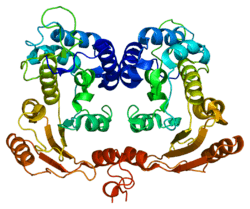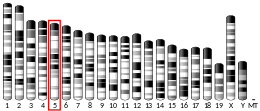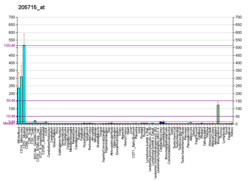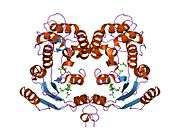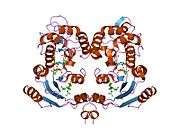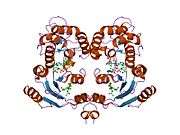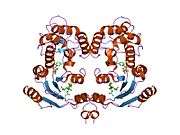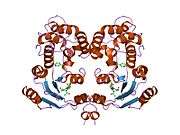BST1
ADP-ribosyl cyclase 2 is an enzyme that in humans is encoded by the BST1 gene.[5][6]
Bone marrow stromal cell antigen-1 is a stromal cell line-derived glycosylphosphatidylinositol-anchored molecule that facilitates pre-B-cell growth. The deduced amino acid sequence exhibits 33% similarity with CD38. BST1 expression is enhanced in bone marrow stromal cell lines derived from patients with rheumatoid arthritis. The polyclonal B-cell abnormalities in rheumatoid arthritis may be, at least in part, attributed to BST1 overexpression in the stromal cell population.[6]
See also
References
- GRCh38: Ensembl release 89: ENSG00000109743 - Ensembl, May 2017
- GRCm38: Ensembl release 89: ENSMUSG00000029082 - Ensembl, May 2017
- "Human PubMed Reference:". National Center for Biotechnology Information, U.S. National Library of Medicine.
- "Mouse PubMed Reference:". National Center for Biotechnology Information, U.S. National Library of Medicine.
- Kaisho T, Ishikawa J, Oritani K, Inazawa J, Tomizawa H, Muraoka O, Ochi T, Hirano T (Jul 1994). "BST-1, a surface molecule of bone marrow stromal cell lines that facilitates pre-B-cell growth". Proc Natl Acad Sci U S A. 91 (12): 5325–9. doi:10.1073/pnas.91.12.5325. PMC 43987. PMID 8202488.
- "Entrez Gene: BST1 bone marrow stromal cell antigen 1".
External links
Further reading
- Ortolan E, Vacca P, Capobianco A, et al. (2003). "CD157, the Janus of CD38 but with a unique personality". Cell Biochem. Funct. 20 (4): 309–22. doi:10.1002/cbf.978. PMID 12415565.
- Lee BO, Ishihara K, Denno K, et al. (1996). "Elevated levels of the soluble form of bone marrow stromal cell antigen 1 in the sera of patients with severe rheumatoid arthritis". Arthritis Rheum. 39 (4): 629–37. doi:10.1002/art.1780390414. PMID 8630113.
- Kajimoto Y, Miyagawa J, Ishihara K, et al. (1996). "Pancreatic islet cells express BST-1, a CD38-like surface molecule having ADP-ribosyl cyclase activity". Biochem. Biophys. Res. Commun. 219 (3): 941–6. doi:10.1006/bbrc.1996.0327. PMID 8645283.
- Okuyama Y, Ishihara K, Kimura N, et al. (1997). "Human BST-1 expressed on myeloid cells functions as a receptor molecule". Biochem. Biophys. Res. Commun. 228 (3): 838–45. doi:10.1006/bbrc.1996.1741. PMID 8941363.
- Muraoka O, Tanaka H, Itoh M, et al. (1997). "Genomic structure of human BST-1". Immunol. Lett. 54 (1): 1–4. doi:10.1016/S0165-2478(96)02633-8. PMID 9030974.
- Wimazal F, Ghannadan M, Müller MR, et al. (2000). "Expression of homing receptors and related molecules on human mast cells and basophils: a comparative analysis using multi-color flow cytometry and toluidine blue/immunofluorescence staining techniques". Tissue Antigens. 54 (5): 499–507. doi:10.1034/j.1399-0039.1999.540507.x. PMID 10599889.
- Yamamoto-Katayama S, Sato A, Ariyoshi M, et al. (2001). "Site-directed removal of N-glycosylation sites in BST-1/CD157: effects on molecular and functional heterogeneity". Biochem. J. 357 (Pt 2): 385–92. doi:10.1042/0264-6021:3570385. PMC 1221964. PMID 11439087.
- Liang F, Qi RZ, Chang CF (2001). "Signalling of GPI-anchored CD157 via focal adhesion kinase in MCA102 fibroblasts". FEBS Lett. 506 (3): 207–10. doi:10.1016/S0014-5793(01)02912-X. PMID 11602246.
- Yamamoto-Katayama S, Ariyoshi M, Ishihara K, et al. (2002). "Crystallographic studies on human BST-1/CD157 with ADP-ribosyl cyclase and NAD glycohydrolase activities". J. Mol. Biol. 316 (3): 711–23. doi:10.1006/jmbi.2001.5386. PMID 11866528.
- Strausberg RL, Feingold EA, Grouse LH, et al. (2003). "Generation and initial analysis of more than 15,000 full-length human and mouse cDNA sequences". Proc. Natl. Acad. Sci. U.S.A. 99 (26): 16899–903. doi:10.1073/pnas.242603899. PMC 139241. PMID 12477932.
- Funaro A, Ortolan E, Ferranti B, et al. (2005). "CD157 is an important mediator of neutrophil adhesion and migration". Blood. 104 (13): 4269–78. doi:10.1182/blood-2004-06-2129. PMID 15328157.
- Gerhard DS, Wagner L, Feingold EA, et al. (2004). "The status, quality, and expansion of the NIH full-length cDNA project: the Mammalian Gene Collection (MGC)". Genome Res. 14 (10B): 2121–7. doi:10.1101/gr.2596504. PMC 528928. PMID 15489334.
- Hillier LW, Graves TA, Fulton RS, et al. (2005). "Generation and annotation of the DNA sequences of human chromosomes 2 and 4". Nature. 434 (7034): 724–31. doi:10.1038/nature03466. PMID 15815621.
- Liu T, Qian WJ, Gritsenko MA, et al. (2006). "Human plasma N-glycoproteome analysis by immunoaffinity subtraction, hydrazide chemistry, and mass spectrometry". J. Proteome Res. 4 (6): 2070–80. doi:10.1021/pr0502065. PMC 1850943. PMID 16335952.
This article incorporates text from the United States National Library of Medicine, which is in the public domain.
This article is issued from Wikipedia. The text is licensed under Creative Commons - Attribution - Sharealike. Additional terms may apply for the media files.
